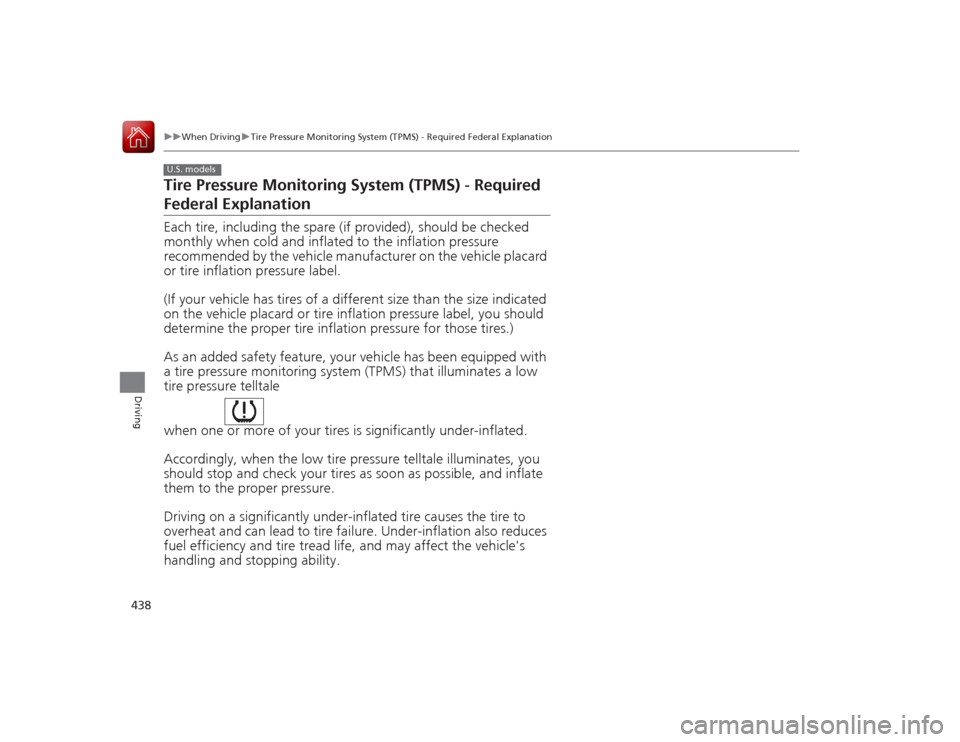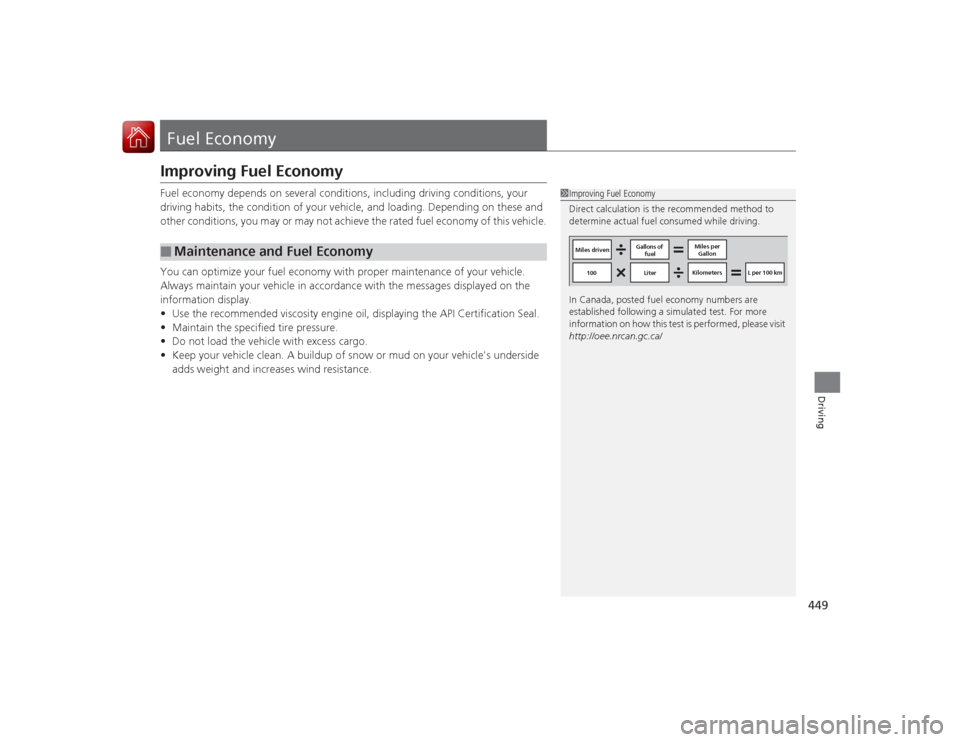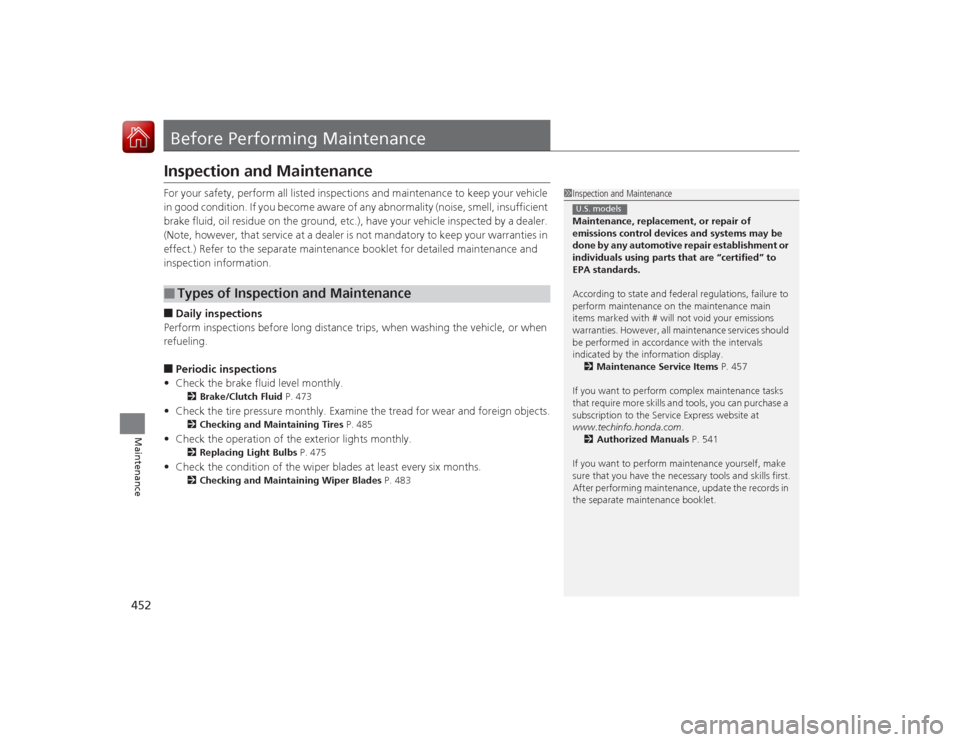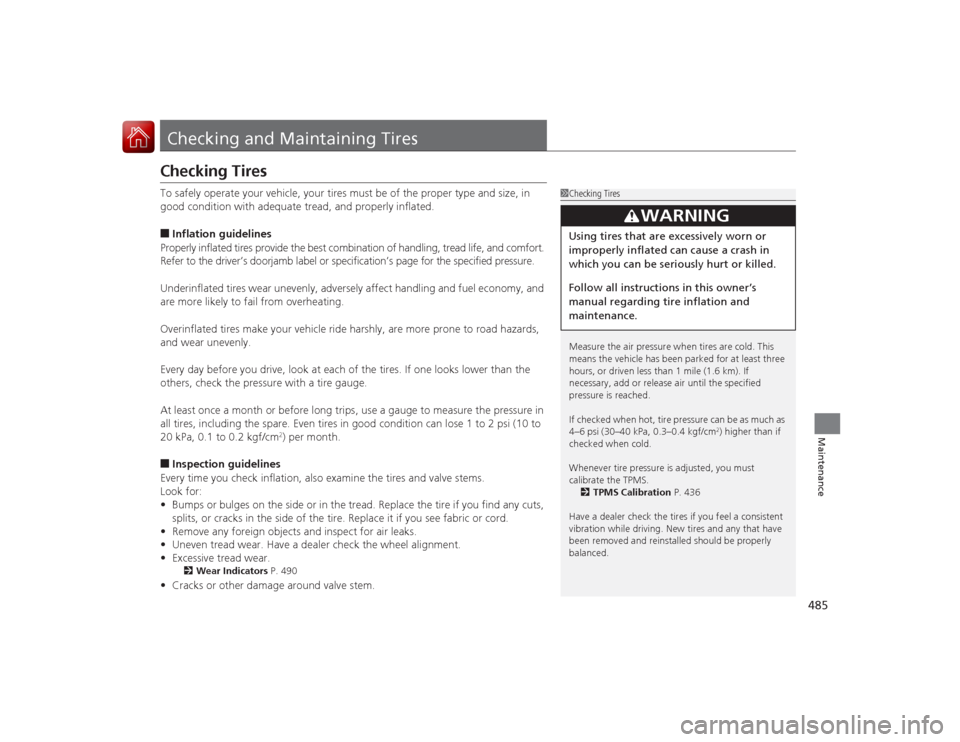2015 HONDA ACCORD COUPE fuel pressure
[x] Cancel search: fuel pressurePage 12 of 557

11Quick Reference Guide
Instrument Panel
(P 67)
CanadaU.S.
Low Fuel IndicatorAnti-lock Brake
System (
ABS)
Indicator
Parking Brake
and Brake System
Indicator (Red)
Canada U.S.
Washer Level
Indicator
*
System Indicators
Malfunction
Indicator Lamp
Low Oil Pressure
Indicator
Charging System
Indicator
Vehicle Stability
Assist (VSA ®) System
Indicator
VSA ® OFF Indicator
Low Tire Pressure/
TPMS Indicator
Electric Power
Steering (EPS) System
Indicator
Lights Indicators
Lights On Indicator
High Beam Indicator
Fog Light Indicator
*
Immobilizer System
Indicator
Seat Belt Reminder
Indicator
System Indicators
CRUISE CONTROL
Indicator CRUISE MAIN
Indicator
Tachometer
Speedometer
Fuel Gauge
Security System
Alarm Indicator
Shift Lever
Position
Indicator
*
Gauges
(P 81)
/Information Display
(P 82)
/
System Indicators
(P 68)
Turn Signal and
Hazard Warning
IndicatorsSystem Indicators
Temperature Gauge
M (7-speed manual shift mode)
Indicator/Shift Indicator
Maintenance Minder
IndicatorSmart Entry System
Indicator
*
Starter System
Indicator
*
ECON mode
IndicatorForward Collision
Warning (
FCW
) Indicator
*
Lane Departure Warning
(LDW
) Indicator
*
Light Control
Indicator
*
Door and Trunk
Open Indicator Brake System
Indicator (Amber)
Supplemental
Restraint System
Indicator
Canada U.S.
Continuously variable
transmission (CVT) modelsM
(Sequential shift mode)
Indicator/Gear position
IndicatorAutomatic transmission models
* Not available on all models
Page 21 of 557

20Quick Reference Guide
VSA® OFF Button
(P 433)
● The vehicle stability assist (VSA ®) system
helps stabilize the vehicle during
cornering, and helps maintain traction
while accelerating on loose or slippery
road surfaces.
● VSA ® comes on automatically every time
you start the engine.
● To turn VSA ® on or off, press and hold
the button until you hear a beep.
Cruise Control
(P 421)
● Cruise control allows you to maintain a
set speed without keeping your foot on
the accelerator pedal.
● To use cruise control, press the CRUISE
button, then press the –/SET button once
you have achieved the desired speed
(above 25 mph or 40 km/h).
Tire Pressure Monitoring
System (TPMS)
(P 436)
● Detects a change in tire conditions and
overall dimensions due to decrease in tire
pressures.
● The TPMS is turned on automatically
every time you start the engine.
● A calibration proc edure must be
performed when certain conditions arise.
Refueling
(P 447)
Fuel recommendation: Unleaded gasoline with a pump octane number 87 or
higher required
Fuel tank capacity: 17.2 US gal (65 L)a
Push the fuel fill door
release handle.
b
Turn the fuel fill cap
slowly to remove the
cap.
c
Place the cap in the
holder on the fuel fill
door.
d
After refueling, screw
the cap back on until it
clicks at least once.
Page 392 of 557

391
Driving
This chapter discusses driving, refueling, and information on items such as accessories.
Before DrivingDriving Preparation .......................... 392
Maximum Load Limit........................ 395
Towing a Trailer Towing Preparation .......................... 397
Driving Safely with a Trailer .............. 399
Towing Your Vehicle ........................ 400
When Driving Starting the Engine .................. 401, 403
Precautions While Driving................. 407
Automatic Transmission/CVT
*.......... 408
Shifting ............................ 409, 413, 417
ECON Button ................................... 420 Cruise Control ................................. 421
Forward Collision Warning (FCW)
*.... 424
Lane Departure Warning (LDW)*..... 428
Vehicle Stability Assist (VSA
®), aka Electronic
Stability Control (ESC), System ............... 432
LaneWatch
TM*.......................................... 434
Tire Pressure Monitoring System (TPMS) ... 436
Tire Pressure Monitoring System (TPMS) - Required Federal Explanation ......... 438
Braking
Brake System ................................... 440
Anti-lock Brake System (ABS) ........... 442 Brake Assist System ......................... 443
Parking Your Vehicle When Stopped ................................ 444
Multi-View Rear Camera .................. 445
Rearview Camera ............................. 446
Refueling Fuel Information .............................. 447
How to Refuel ................................. 448
Fuel Economy Improving Fuel Economy .................. 449
Accessories and Modifications ........ 450
* Not available on all models
Page 439 of 557

438
uuWhen Driving uTire Pressure Monitoring System (TPMS) - Required Federal Explanation
Driving
Tire Pressure Monitoring System (TPMS) - Required Federal ExplanationEach tire, including the spare (if provided), should be checked
monthly when cold and inflated to the inflation pressure
recommended by the vehicle manufa cturer on the vehicle placard
or tire inflation pressure label.
(If your vehicle has tires of a different size than the size indicated \
on the vehicle placard or tire inflation pressure label, you should
determine the proper tire inflation pressure for those tires.)
As an added safety feature, your vehicle has been equipped with
a tire pressure monitoring system (TPMS) that illuminates a low
tire pressure telltale
when one or more of your tire s is significantly under-inflated.
Accordingly, when the low tire pressure telltale illuminates, you
should stop and check your tires as soon as possible, and inflate
them to the proper pressure.
Driving on a significantly under-inflated tire causes the tire to
overheat and can lead to tire failure. Un der-inflation also reduces
fuel efficiency and tire tread life, and may affect the vehicle's
handling an d stopping ability.U.S. models
Page 450 of 557

449Driving
Fuel EconomyImproving Fuel EconomyFuel economy depends on several conditions, including driving conditions, your
driving habits, the condition of your vehicle, and loading. Depending on these and
other conditions, you may or may not achieve the rated fuel economy of this vehicle.
You can optimize your fuel economy with proper maintenance of your vehicle.
Always maintain your vehicle in accordance with the messages displayed on the
information display.
• Use the recommended viscosity engine oil, displaying the API Certification Seal.
• Maintain the specified tire pressure.
• Do not load the vehicle with excess cargo.
• Keep your vehicle clean. A buildup of snow or mud on your vehicle's underside
adds weight and increases wind resistance.■
Maintenance and Fuel Economy
1Improving Fuel Economy
Direct calculation is the recommended method to
determine actual fuel consumed while driving.
In Canada, posted fuel economy numbers are
established following a simulated test. For more
information on how this test is performed, please visit
http://oee.nrcan.gc.ca/
Miles driven Gallons of
fuel Miles per
Gallon
100 Liter Kilometers L per 100 km
Page 453 of 557

452Maintenance
Before Performing MaintenanceInspection and MaintenanceFor your safety, perform all listed inspections and maintenance to keep your vehicle
in good condition. If you become aware of any abnormality (noise, smell, insufficient
brake fluid, oil residue on the ground, etc.), have your vehicle inspected by a dealer.
(Note, however, that service at a dealer is not mandatory to keep your \
warranties in
effect.) Refer to the separate maintenance booklet for detailed maintenance and
inspection information.■Daily inspections
Perform inspections before long distance trips, when washing the vehicle, or when
refueling.■Periodic inspections
• Check the brake fluid level monthly.2 Brake/Clutch Fluid P. 473
•Check the tire pressure monthly. Examine the tread for wear and foreign objects.
2 Checking and Maintaining Tires P. 485
•Check the operation of the exterior lights monthly.
2 Replacing Light Bulbs P. 475
•Check the condition of the wiper blades at least every six months.
2Checking and Mainta ining Wiper Blades P. 483
■
Types of Inspection and Maintenance
1Inspection and Maintenance
Maintenance, replacement, or repair of
emissions control devices and systems may be
done by any automotive repair establishment or
individuals using parts that are “certified” to
EPA standards.
According to state and federal regulations, failure to
perform maintenance on the maintenance main
items marked with # will not void your emissions
warranties. However, all maintenance services should
be performed in accordance with the intervals
indicated by the information display. 2 Maintenance Service Items P. 457
If you want to perform complex maintenance tasks
that require more skills and tools, you can purchase a
subscription to the Service Express website at
www.techinfo.honda.com .
2 Authorized Manuals P. 541
If you want to perform maintenance yourself, make
sure that you have the necessary tools and skills first.
After performing maintenance, update the records in
the separate maintenance booklet.U.S. models
Page 486 of 557

485Maintenance
Checking and Maintaining TiresChecking TiresTo safely operate your vehicle, your tires must be of the proper type and size, in
good condition with adequate tread, and properly inflated.■Inflation guidelines
Properly inflated tires provide the best co mbination of handling, tread life, and comfort.
Refer to the driver’s doorjamb label or specification’s page for the specified pressure.
Underinflated tires wear unevenly, adversely affect handling and fuel economy, and
are more likely to fail from overheating.
Overinflated tires make your vehicle ride harshly, are more prone to road hazards,
and wear unevenly.
Every day before you drive, look at each of the tires. If one looks lower than the
others, check the pressure with a tire gauge.
At least once a month or before long trips, use a gauge to measure the pressure in
all tires, including the spare. Even tires in good condition can lose 1 to 2 psi (10 to
20 kPa, 0.1 to 0.2 kgf/cm
2) per month.
■Inspection guidelines
Every time you check inflation, also examine the tires and valve stems.
Look for:
• Bumps or bulges on the side or in the tread. Replace the tire if you find any cuts,
splits, or cracks in the side of the tire. Replace it if you see fabric or cord.
• Remove any foreign objects and inspect for air leaks.
• Uneven tread wear. Have a dealer check the wheel alignment.
• Excessive tread wear.2 Wear Indicators P. 490
•Cracks or other damage around valve stem.
1Checking Tires
Measure the air pressure when tires are cold. This
means the vehicle has been par ked for at least three
hours, or driven less than 1 mile (1.6 km). If
necessary, add or release air until the specified
pressure is reached.
If checked when hot, tire pressure can be as much as
4–6 psi (30–40 kPa, 0.3–0.4 kgf/cm
2) higher than if
checked when cold.
Whenever tire pressure is adjusted, you must
calibrate the TPMS. 2 TPMS Calibration P. 436
Have a dealer check the tires if you feel a consistent
vibration while driving. New tires and any that have
been removed and reinstalled should be properly
balanced.
3
WARNING
Using tires that are excessively worn or
improperly inflated can cause a crash in
which you can be seri ously hurt or killed.
Follow all instruc tions in this owner’s
manual regarding tire inflation and
maintenance.
Page 547 of 557

Index
546Index
Index
Numbers7-Speed Manual Shift Mode.................... 411
Operation ................................................ 412AABS (Anti-lock Brake System) ................... 442
Accessories and Modifications ................. 450
Accessory Power Sockets .......................... 140
Additives
Coolant ................................................... 469
Engine Oil ................................................ 463
Washer .................................................... 474
Additives, Engine Oil ................................ 463
Adjusting Clock ......................................................... 86
Front Seats .............................................. 127
Head Restraints........................................ 130
Mirrors .................................................... 125
Rear Seats................................................ 134
Steering Wheel ........................................ 124
Temperature .............................................. 84
Aha
TM Radio ...................................... 205, 258
Air Conditioning System (Climate Control
System) .................................................... 144
Changing the Mode ................................ 144
Defrosting the Windshield and
Windows ............................................... 145
Dust and Pollen Filter ............................... 497
Recirculation/Fresh Air Mode ................... 144
Sensor ..................................................... 147 Synchronized Mode................................. 146
Using Automatic Climate Control ............ 144
Air Pressure ............................... 486, 531, 533
Airbags ........................................................ 39
Advanced Airbags ..................................... 45
After a Collision ........................................ 42
Airbag Care............................................... 51
Event Data Recorder .................................... 0
Front Airbags (SRS) .................................... 42
Indicator.............................................. 49, 72
Passenger Airbag Off Indicator .................. 50
Sensors ..................................................... 39
Side Airbags .............................................. 46
Side Curtain Airbags.................................. 48
AM/FM Radio ............................ 163, 189, 228
Anti-lock Brake System (ABS) .................. 442
Indicator.................................................... 71
Audio Remote Controls ........................... 155
Audio System ............................................ 150
Adjusting the Sound................ 161, 187, 218
Auxiliary Input Jack.................................. 152
Error Messages ........................................ 264
General Information ................................ 270
HDD ........................................................ 238
Internet Radio ......................... 171, 203, 256
iPod ........................................ 168, 199, 248
MP3/WMA/AAC ...................... 173, 206, 259
Reactivating ............................................ 153
Recommended CDs ................................. 271
Recommended Devices............................ 273
Remote Controls ..................................... 155 Security Code ......................................... 153
Theft Protection ...................................... 153
Touch Screen .................................. 179, 212
USB Flash Drives...................................... 273
USB Port ................................................. 151
Authorized Manuals ................................ 541
Auto Door Locking/Unlocking .................. 98
Customize ...................................... 285, 303
Automatic Lighting .................................. 116
Automatic Transmission Creeping................................................. 408
Fluid ....................................................... 472
Kickdown ............................................... 408
Operating the Shift Lever .................. 19, 414
Shift Lever Does Not Move ...................... 517
Shifting ................................................... 413
Auxiliary Input Jack ................................. 152
Average Fuel Economy .............................. 83
BBattery...................................................... 494
Charging System Indicator ................ 69, 520
Jump Starting ......................................... 514
Maintenance (Checking the Battery) ....... 494
Maintenance (Replacing) ......................... 495
Belts (Seat) .................................................. 32
Beverage Holders ..................................... 139
Bluetooth ® Audio ..................... 176, 209, 262
Bluetooth ® HandsFreeLink ®............. 314, 351
Booster Seats (For Children) ...................... 63